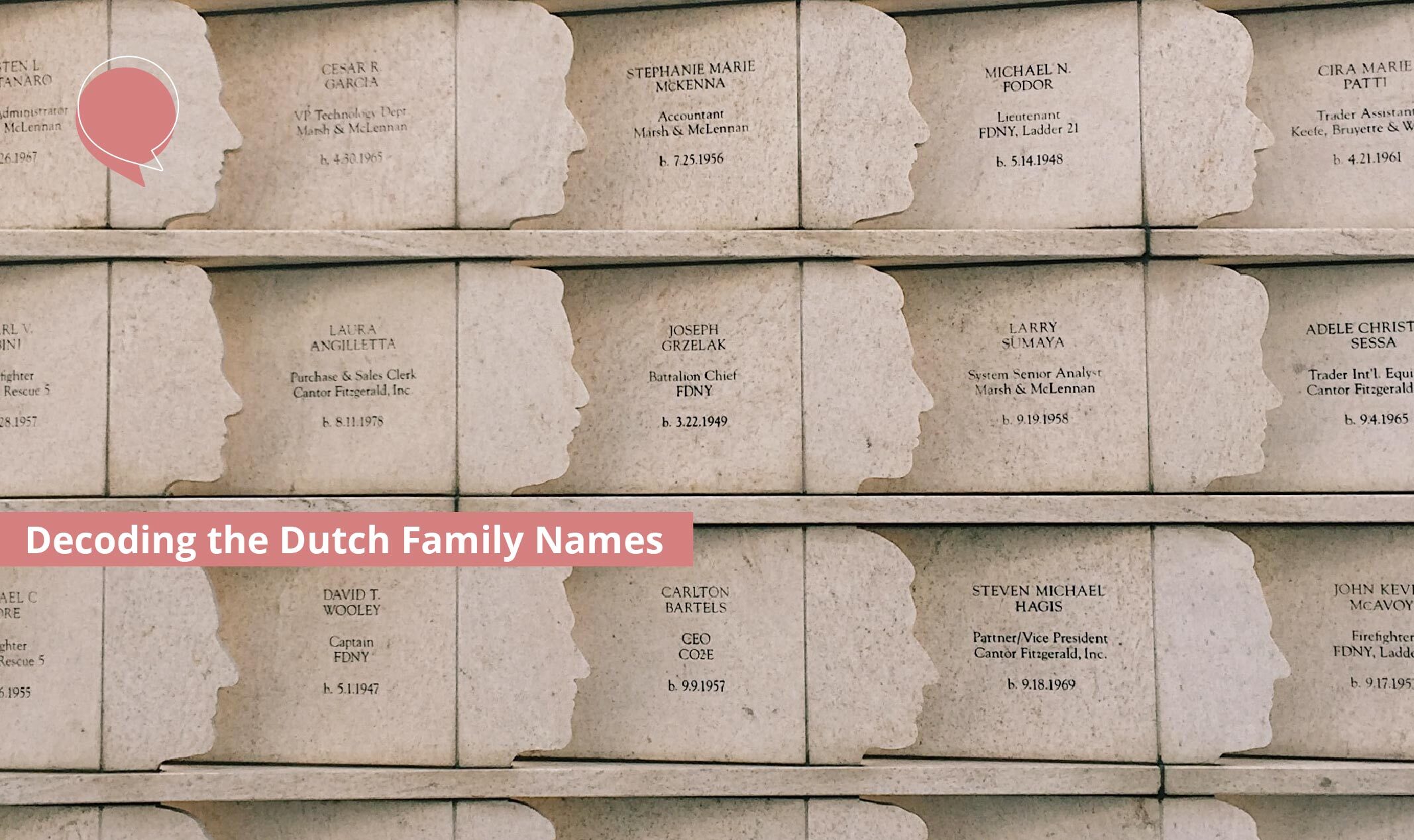
Decoding the Dutch Family Names
Written by – Willem van Hoorn
Ever wonder what a particular Dutch family name means? Or where it comes from?
The Origin and Meaning of the Dutch Family names
The early 1800’s laid the foundations of today’s Dutch civic administration. At that time, the Netherlands were occupied by France for a couple of years. The French introduced their civic administration system in the Netherlands, and it has always remained since then. Consequently, around the year 1800, every Dutchman had to come to the ‘stadhuis’ or ‘gemeentehuis’ (city hall) and register a family name. Since then, the Dutch family names are fixed, and no longer change from generation to generation.
Examples of Dutch family names
 Some people at the time chose to register their profession as a family name. So, we have names like Smit (Blacksmith), de Boer (the Farmer), Timmerman (Carpenter), Visser (Fisherman) or den Bakker (the Baker).
Some people at the time chose to register their profession as a family name. So, we have names like Smit (Blacksmith), de Boer (the Farmer), Timmerman (Carpenter), Visser (Fisherman) or den Bakker (the Baker).
Others chose their father’s name, as a family name, with the suffix ‘sen’, indicating ‘son of’. So, we got Jansen (meaning Jan’s son), or Petersen (Peter’s son), and so on. Still, others would choose a family name that reflected either a dream or an ambition, but seldom a reality. Examples are de Keizer (the Emperor), de Koning (the King), den Hertog (the Duke), or de Graaf (the Earl).
Many chose the name of the city or village that they came from as a family name, preceded by the prefix ‘van’. In this context ‘van’ means: ‘(coming) from’. An example would be ‘Van Eindhoven’.
‘Van Somewhere’ in the phone directory
We have a lot of ‘Van Somewhere’: Van Amsterdam, Van Maastricht, Van Delft, etc. Note that, if used in conjunction with the first name, ‘van’ is NOT written with a capital V: Jan van Delft. There are so many Van Somewhere that usually they are not listed under the ‘V’ in our phone directories. If you would look up Mrs. Maria van Somewhere in a Dutch phone directory, you will find her under the letter S, listed as: ‘Somewhere, M. van’.
This makes sense. Roughly 20% of our family names is a ‘van Somewhere’, so that is hardly a distinctive criterion. The ‘V’-section of the phone directory would account for more than 20% of the whole population.
Oh, by the way: some Dutchmen in those early 1800’s did not take this new civic administration system very seriously. They thought it was a bit of a joke that would go away in a couple of years. Their descendants inherited family names that I would rather not translate here 😉 Especially for the sake of the descendants of these jokers who, through no fault of their own, sometimes inherited rather embarrassing family names, around 40 years ago, the Dutch government made it easier (and cheaper) to modify your family name.
Family Name last
The Dutch put their family name last and their given name first. According to cultural scientists, that coincides with the comparatively individualistic culture. It is opposed to many other cultures, where they put the family name first and sometimes reserve the ‘first’ name (given name) for use within the family and very close friends only. That usually coincides with more collectivist cultures, where family and other in-groups are seen as more important.
Dutch Family Names after Marriage
 Traditionally in the Netherlands, after a marriage the wife would take the family name of the husband, often followed by her own family name: Mrs. [his family name] – [her family name].
Traditionally in the Netherlands, after a marriage the wife would take the family name of the husband, often followed by her own family name: Mrs. [his family name] – [her family name].
Since a couple of decades that is no longer mandatory, she can choose to carry on with her own family name. By default, children born in a family get the father’s family name. But the parents may decide to give the children the family name of the mother. In any case: all the children in one family must be given the same family name.
The use of First Names
The Dutch rather easily get on a first name basis. That reflects their egalitarian culture. Example: when you start to work at a Dutch company, there is a fair chance that your boss will invite you to call him or her by the first name.
It may be that you need some time to get used to this. For some it may feel disrespectful to do so, especially if their superior is someone with big authority or expertise. Or you may be used to reserve the first name for very close family members and close friends only. At least know this: when a Dutch person invites you to call him or her by their first name, they do mean it. In that case it is OK to do so, at least from their perspective.
Social Code about First Name
There is a bit of a social code involved in the use of the first name, but it is subtle and somewhat hidden. Let me try to explain.
When a Dutch person introduces him/herself as ‘[first name] followed by [family name]’, (s)he more or less expects the other person to address him or her by the first name, especially if it is in an informal situation or among direct colleagues.
When (s)he would introduce as: “My name is [family name]”, it would be safe to start with ‘Mister or Misses [family name]’. If you feel insecure how to address him or her, it is fine if you would just check: ‘Is it OK if I call you by your first name?’ The answer will likely be “Yes, please do”. And if it isn’t, you just managed to circumvent an uneasy moment.

Willem van Hoorn works as a Policy Advisor Internationalization at Eindhoven University of Technology. He has been leading several projects and initiatives in the Brainport region to achieve integration and internationalization. When he’s not reading or writing, Willem is often brainstorming for innovative ideas, connecting with others, or bicycling towards the coast.
To comment on this post or anything else you have seen on Expat Spouses Initiative page, please message us on Facebook or email us.

Please feel free to ask questions, make remarks, or suggest other sources.
In collaboration with

